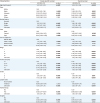1. Torre LA, Bray F, Siegel RL, Ferlay J, Lortet-Tieulent J, Jemal A. Global cancer statistics, 2012. CA Cancer J Clin. 2015; 65:87–108.

3. Vinh-Hung V, Bourgain C, Vlastos G, Cserni G, De Ridder M, Storme G, et al. Prognostic value of histopathology and trends in cervical cancer: a SEER population study. BMC Cancer. 2007; 7:164.

4. Peters WA 3rd, Liu PY, Barrett RJ 2nd, Stock RJ, Monk BJ, Berek JS, et al. Concurrent chemotherapy and pelvic radiation therapy compared with pelvic radiation therapy alone as adjuvant therapy after radical surgery in high-risk early-stage cancer of the cervix. J Clin Oncol. 2000; 18:1606–1613.

5. Sedlis A, Bundy BN, Rotman MZ, Lentz SS, Muderspach LI, Zaino RJ. A randomized trial of pelvic radiation therapy versus no further therapy in selected patients with stage IB carcinoma of the cervix after radical hysterectomy and pelvic lymphadenectomy: a Gynecologic Oncology Group study. Gynecol Oncol. 1999; 73:177–183.

6. Randall ME, Michael H, Long H, Tedjarati S. Uterine cervix. In : Barakat RR, Markman M, Randall ME, editors. Principles and practice of gynecologic oncology. 5th ed. Philadelphia, PA: Wolters Kluwer/Lippincott Williams & Wilkins;2009. p. 623–681.
7. Kosary CL. FIGO stage, histology, histologic grade, age and race as prognostic factors in determining survival for cancers of the female gynecological system: an analysis of 1973–87 SEER cases of cancers of the endometrium, cervix, ovary, vulva, and vagina. Semin Surg Oncol. 1994; 10:31–46.

8. Hopkins MP, Morley GW. Stage IB squamous cell cancer of the cervix: clinicopathologic features related to survival. Am J Obstet Gynecol. 1991; 164:1520–1527.

9. Zaino RJ, Ward S, Delgado G, Bundy B, Gore H, Fetter G, et al. Histopathologic predictors of the behavior of surgically treated stage IB squamous cell carcinoma of the cervix. A Gynecologic Oncology Group study. Cancer. 1992; 69:1750–1758.

10. Stock RJ, Zaino R, Bundy BN, Askin FB, Woodward J, Fetter B, et al. Evaluation and comparison of histopathologic grading systems of epithelial carcinoma of the uterine cervix: Gynecologic Oncology Group studies. Int J Gynecol Pathol. 1994; 13:99–108.
11. Carriaga MT, Henson DE. The histologic grading of cancer. Cancer. 1995; 75:406–421.

12. Kristensen GB, Abeler VM, Risberg B, Tropé C, Bryne M. Tumor size, depth of invasion, and grading of the invasive tumor front are the main prognostic factors in early squamous cell cervical carcinoma. Gynecol Oncol. 1999; 74:245–251.

13. Chung CK, Stryker JA, Ward SP, Nahhas WA, Mortel R. Histologic grade and prognosis of carcinoma of the cervix. Obstet Gynecol. 1981; 57:636–642.
14. Graflund M, Sorbe B, Hussein A, Bryne M, Karlsson M. The prognostic value of histopathologic grading parameters and microvessel density in patients with early squamous cell carcinoma of the uterine cervix. Int J Gynecol Cancer. 2002; 12:32–41.

15. Smiley LM, Burke TW, Silva EG, Morris M, Gershenson DM, Wharton JT. Prognostic factors in stage IB squamous cervical cancer patients with low risk for recurrence. Obstet Gynecol. 1991; 77:271–275.

16. Cancer Genome Atlas Research Network; Albert Einstein College of Medicine. Analytical Biological Services; Barretos Cancer Hospital; Baylor College of Medicine; Beckman Research Institute of City of Hope, et al. Integrated genomic and molecular characterization of cervical cancer. Nature. 2017; 543:378–384.
17. National Cancer Institute (US). The Surveillance, Epidemiology, and End Results (SEER) program of the National Cancer Institute [Internet]. Bethesda, MD: National Cancer Institute;2018. cited 2018 Mar 22. Available from:
https://seer.cancer.gov/.
18. National Cancer Registrars Association (US). Alexandria, VA: National Cancer Registrars Association;cited 2018 Sep 3. Available from:
http://www.ncra-usa.org.
19. Matsuo K, Machida H, Shoupe D, Melamed A, Muderspach LI, Roman LD, et al. Ovarian conservation and overall survival in young women with early-stage cervical cancer. Obstet Gynecol. 2017; 129:139–151.

20. Matsuo K, Machida H, Horowitz MP, Shahzad MM, Guntupalli SR, Roman LD, et al. Risk of metachronous ovarian cancer after ovarian conservation in young women with stage I cervical cancer. Am J Obstet Gynecol. 2017; 217:580.e1–580.10.

21. Edge SB, Byrd DR, Compton CC, Fritz AG, Greene FL, Trotti A. AJCC cancer staging manual. 7th ed. New York, NY: Springer;2010.
22. Centers for Disease Control and Prevention (US). National death index [Internet]. Atlanta, GA: Centers for Disease Control and Prevention;2017. cited 2018 Mar 22. Available from:
https://www.cdc.gov/nchs/ndi/.
23. Kaplan EL, Meier P. Nonparametric estimation from incomplete observations. J Am Stat Assoc. 1958; 53:457–481.

24. Cox DR. Regression models and life-tables. J R Stat Soc Series B Stat Methodol. 1972; 34:187–220.

25. Wang R, Lagakos SW, Ware JH, Hunter DJ, Drazen JM. Statistics in medicine--reporting of subgroup analyses in clinical trials. N Engl J Med. 2007; 357:2189–2194.
26. Kidd EA, Spencer CR, Huettner PC, Siegel BA, Dehdashti F, Rader JS, et al. Cervical cancer histology and tumor differentiation affect 18F-fluorodeoxyglucose uptake. Cancer. 2009; 115:3548–3554.
27. National Comprehensive Cancer Network (US). NCCN Clinical Practice Guidelines in Oncology. Cervical cancer [Internet]. Fort Washington, PA: National Comprehensive Cancer Network;cited 2018 Mar 22. Available from:
https://www.nccn.org/.
28. Rose PG, Bundy BN, Watkins EB, Thigpen JT, Deppe G, Maiman MA, et al. Concurrent cisplatin-based radiotherapy and chemotherapy for locally advanced cervical cancer. N Engl J Med. 1999; 340:1144–1153.










 PDF
PDF Citation
Citation Print
Print



 XML Download
XML Download